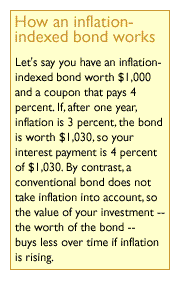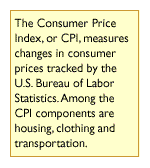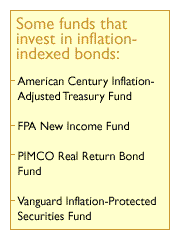|
Riding inflation to riches?
|
 |
June 9, 2000: 4:16 p.m. ET
If you think prices are on the way up, inflation-indexed bonds can be your hedge
By Staff Writer Martine Costello
|
NEW YORK (CNNfn) - Inflation may fuel the rages on Wall Street and affect how far your dollars stretch, but it's not exactly a heart-stopper in investment circles these days.
After all, most people may not remember when soaring inflation in the 1970s doubled the cost of living and crippled many long-term investing portfolios.
But as the main inflation yardstick, the Consumer Price Index, has doubled in the past two years and stoked inflation worries, a new investment is getting more attention for its ability to capitalize on price increases.
 Inflation-index bonds, which rise in value based on the rate of the CPI, have been generating some of the best returns this year in the fixed income market. Inflation-index bonds, which rise in value based on the rate of the CPI, have been generating some of the best returns this year in the fixed income market.
"All other investments go down when inflation goes up," said John Brynjolfsson, manager of PIMCO Real Return Bond Fund. "An investor's portfolio goes down just as inflation goes up. That is a one-two punch that is devastating. But this is different."
Assets in the PIMCO fund have increased tenfold since 1998 to $400 million, Brynjolfsson said. The fund earned 5.45 percent year to date as of May 31 and earned 5.3 percent in 1999. By contrast, the Lehman Brothers U.S. Treasury Index earned 3.62 percent year to date and lost 2.56 percent in 1999.
Formally known as Treasury Inflation-Indexed Securities, or TIPS, they are turning up in a number of diversified bond funds. Other new funds that invest exclusively in TIPS are also debuting. Most recently, popular fund giant Vanguard Group introduced Vanguard Inflation-Protected Securities Fund.
Click here for CNNfn.com's top personal finance stories of the week.
Mid-year tax planning can save you $$$
Five questions to ask your financial planner
Make your resume a killer
Take the tax bite out of your funds
Kids, summer and taxes
What you need to know about fund families
"If investors are worried about inflation, this is a great vehicle for them," said John Hollyer, co-manager of the new Vanguard fund.
 There has been talk of starting inflation-indexed bonds since the 1920s, and the first ones debuted about two and a half years ago with a maturity date of July 2002, said Casey Colton, vice president at American Century funds and a member of the investment team that covers government issues. There has been talk of starting inflation-indexed bonds since the 1920s, and the first ones debuted about two and a half years ago with a maturity date of July 2002, said Casey Colton, vice president at American Century funds and a member of the investment team that covers government issues.
American Century Inflation-Adjusted Treasury Fund is one of the fund group's top-performing bond funds this year, largely because of what's happening with inflation, he said.
"It isn't a market that has matured, but there is more interest," Colton said about inflation-indexed bonds. "Given where inflation has been - I've seen it up 10 to 12 percent - this is a market that should do much better."
The bonds will break even as long as inflation stays at 2.01 percent or above, Colton said. That "break-even inflation rate," represents the difference in yield between a Treasury bond and an inflation-indexed bond.
"If you want to invest in a long-term Treasury security and you think inflation won't ever dip below 2 percent, this makes more sense than a nominal Treasury bond," Colton said.
 While Fed Chairman Alan Greenspan has done a good job of controlling the money supply, there's no guarantee that his replacements over the next 30 years will do the same, Colton said. While Fed Chairman Alan Greenspan has done a good job of controlling the money supply, there's no guarantee that his replacements over the next 30 years will do the same, Colton said.
The economy has been so robust that many people were talking about "deflation" back in 1997 and questioning the value of inflation-indexed bonds.
Robert Rodriguez, manager of the FPA New Income Fund, has been arguing for several years that inflation-indexed bonds are a good way to earn competitive returns with less risk.
Check your mutual funds.
"The camp that argued deflation has been proven wrong," Rodriguez said. "They (inflation-indexed bonds) provide a competitive return with less volatility ... We have been in a period of much reduced returns in stocks. Going forward I think equity returns on average would migrate more to 7 percent levels. This would be a conservative alternative."
FPA New Income Fund has 42 percent of its portfolio in inflation-indexed bond funds. The fund, ranked in the 7th percentile for performance in its category over 10 years, has suffered recently because of an unrelated investment in asset-backed securities in the ailing Conseco Finance.
 Inflation-indexed bonds make sense in a tax-deferred portfolio like an IRA or 401(k) because of the way the IRS taxes income on them, said Rodriguez and Colton. (Click here to read more about 401(k)s and IRAs on CNNfn.com). Inflation-indexed bonds make sense in a tax-deferred portfolio like an IRA or 401(k) because of the way the IRS taxes income on them, said Rodriguez and Colton. (Click here to read more about 401(k)s and IRAs on CNNfn.com).
"It would do very well in a tax-deferred account because you would avoid final reckoning until you cash out the tax-deferred account," Colton said.
But even though inflation-indexed bonds are less sensitive to interest rate swings, there is another important difference. Investors should keep in mind that the yields of inflation-indexed bonds will fluctuate more in the short term because it moves along with changes in the CPI. So they should be prepared for swings.
"From one period to the next, investors could see some income swings," said Hollyer, of the Vanguard fund.
Some funds, like the PIMCO fund, also invest in international inflation-indexed bonds. PIMCO invests in bonds from Sweden, the United Kingdom and New Zealand. The bonds are pegged to the inflation rates in those countries.
Hollyer said the TIPS market has expanded enough to support a fund that invests in them exclusively. There are bonds with short to long maturities, more issuances overall; and the market has become more liquid as more investors have bought them.
"There's been a fairly dramatic expansion of the investor universe," Hollyer said. "This has happened since the end of 1999." 
|
|
|
|
|
 |

|

